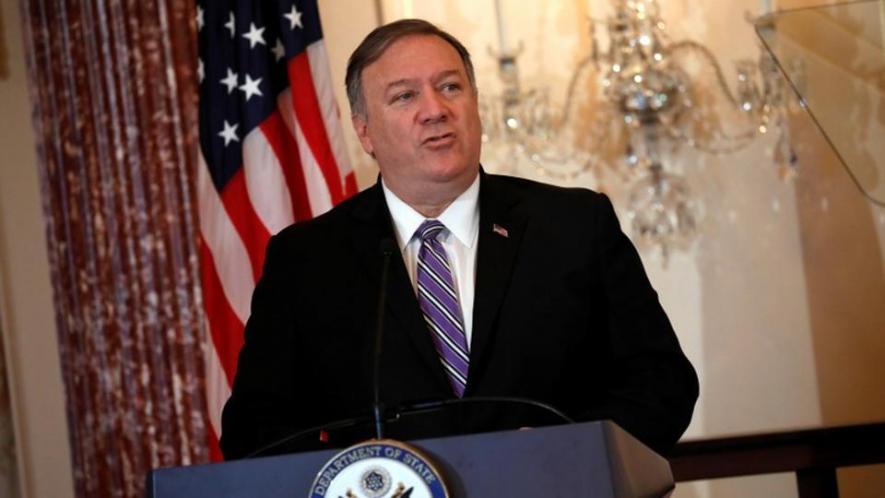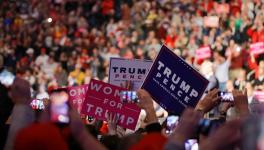Mike Pompeo’s India Visit: What’s on the Agenda?

Mike Pompeo's visit to India comes ahead of a meeting between Donald Trump and Narendra Modi in Osaka on the sidelines of the g-20 summit.
Mike Pompeo, the US Secretary of State, is slated to visit India for two days from June 25. It will be a preparatory visit for the Narendra Modi-Donald Trump meeting on the sidelines of G-20 summit in Osaka, Japan on June 28-29. Contrary to the euphoria around the visit in the Indian media, there are several areas of contention between the US and India. Most of the problems are the result of Trump administration following an aggressive nationalist and imperialist policy. Pompeo may try and get a favorable resolution from the US perspective to some of those problems. Some experts have pointed out that in recent times, the Modi government has slightly moved away from its complete surrender to US agenda and has begun expanding and strengthening ties with other powers such as Russian and China. Pompeo’s visit is thus an attempt to bring India back into the fold. The question is whether the Modi government caves in to US pressure or not. If it does, it would be another blow to India’s credibility globally. Pompeo’s visit and the meeting in Osaka will thus be crucial tests for whatever remains of India’s independent foreign policy.
The agenda for the visit was stated by Pompeo on June 12. Addressing the annual India Idea Summit organised by the US-India Business Council in Washington, he raised some of the US’ concerns with India. He alleged that there were trade barriers put in place by the Indian government which were preventing US business from having meaningful trade relations. He also raised the issue of data localization proposed by the Indian government. Pompeo, echoing Trump’s “tariff king” remarks about India, demanded that the Indian government take pro-active measures to solve these problems. In the upcoming visit, Pompeo is likely to pressurize the Indian government into complying with US demands on the issue.
India’s independent foreign policy?
The list of issues of contention between the two countries is long. The US is very unhappy with India’s purchase of the S-400 anti-missile system from Russia. India, on the other hand, considers the Russian surface-to-air missile defence system as one of the most advanced in the world today and signed a deal worth $5 billion in October. At that point, the US had threatened to impose sanctions if India went ahead with the deal. The Trump administration cited the Countering America’s Adversaries Through Sanctions Act (CAATSA), under which the country which indulges in arms trade with an ‘adversary’ of the US can be sanctioned. Though the threat of sanctions was dropped with the US Congress providing an exemption to India, various officials have issued threats of withdrawal from any future transfer of high technology hardware to India. The US also threatens to block sales of F-35 combat aircraft to India. Turkey is already facing such threats.
There is no doubt that the US threat of serious consequences is a motivated attempt to minimize competition in the global arms trade. Since India is one of the biggest buyers of weapons in the world, the US wants to have greater control over its market and push out Russia which has been the largest supplier of weapons to India. It would be interesting to see how India responds to the US pressure on Russia. Given the talks of a “new cold war” between Russia and the US, the Indian position becomes crucial to the US for strategic reasons too. Of course there is also the carrot in addition to the proverbial stick. Reports say the US might consider India’s inclusion in its International Traffic in Arms Regulations (ITAR), which would facilitate faster and greater military technology transfers to India. However, it is clear that the price India has to pay will be its independent foreign policy.
Indian also sees Pompeo’s visit as an opportunity to raise the issue of Iran sanctions. The US ended the exemptions from the sanctions to eight countries, including India, in May this year. This led India to stop buying oil from Iran, its third largest supplier. The US sanctions have put India at a disadvantage because Iranian oil was cheaper and came with a longer credit period and better payment arrangement. Though the sanctions are unilateral and have no international legal backing, India still complied with them since it did not want to anger the Trump administration even at the risk of harming its long-established relations with Iran. It was a classic case of compromising on Indian interests, as well as long cherished principles of Indian foreign policy. Despite India’s efforts in this direction, it is unlikely that the Trump administration will consider Indian concerns and provide fresh exemptions given the recent developments in the Persian Gulf region.
Yet another issue which will test the Modi government’s commitment to Indian sovereign policy and its relations with China is the issue of 5G technology. The Chinese company, Huawei, has been banned from trading with the US companies in the context of the ongoing trade war between both the countries. Huawei is one of the leaders in 5G technology. India’s attempts to introduce such technology would be hampered or delayed if it caves under the US pressure and does not deal with Huawei. Foreign policy experts in India see it as the key to the US strategy vis-à-vis China in the South Asian region. These experts does not see any problem in India toeing the imperialist line. Such foreign policy analysts would argue in favour of India looking for an alternative to Huawei. The talks of BRICS (Brazil, Russia, India, China and South Africa) as a group to counter rising US hegemony in the world politics has become irrelevant for them.
Pompeo is also likely to push for a stronger Indian role in the US campaign against Iran. India has already voted in favour of Israel this month and has refrained from criticizing Trump’s move to recognise the occupied Syrian Golan Heights as Israeli territory. With the controversial deal of the century coming out soon, India’s stance on the issue may also figure in the discussions.
H1 B visa and Data Localization
Another key front is the issue of trade of goods, services and arms. The US approach is to blame India for all the problem areas. Last year, the US’ National Trade Estimate report listed out a series of issues raised by US firms in India. These range from high tariffs, price control of medical devices, preference to domestically produced products in government procurement enforcement of intellectual property and data localization requirements. They see the Indian policy of promoting Indian manufacturing through insistence on local content as a form of trade barrier or protectionism. Of course, the US administration conveniently ignores the fact that the US too has issued an executive order named “Buy American, Hire American” under which hiring foreign staff and buying foreign goods should be discouraged. Under the order, the number of Indian computer and other technical professionals getting H1B visas will come down drastically.
Currently around 70% of all those given these visas (around 85,000) come from India. Reuters had reported recently that after the implementation of the order, the percentage of professionals from India would be capped at 10- 15%. The report also mentions that this policy aims to counter the Indian government’s move to ensure localization of data. The Indian government wants all the companies working in the country to store all the data related to their customers locally. Companies from the US, such as Mastercard, want the free flow of data across the borders. They claim that is necessary for technological innovation and better service delivery. The Indian government, like many other governments across the world, sees data as an asset that needs to be regulated for both reasons of national security and competitive advantage. Though in the context of Pompeo’s visit, the state department has issued a clarification and denied any such move to fix the number of H1B visas from India, it might be a temporary relief.
Trade
The total volume of trade of goods and services between India and the US was $ 142 billion last year. Indian exports stood at around $ 83 billion. Since India was a beneficiary developing country under the Generalised System of Preferences first implemented in 1974, it got duty exemption for certain goods. In 2017, $ 5.7 billion worth of goods got benefited under the scheme. However, in the first week of June this year Trump administration chose to withdraw these exemptions. This was a result of Trump administration’s accusing India of preventing its firms from having “equitable and reasonable” access to its market through the imposition of trade barriers as per the US’ National Trade Estimate report 2018 mentioned above. The impact of the withdrawal would be mostly on the exports related to plastic and iron and steel industry in India. Though India has decided to retaliate with similar tariffs on 29 imported items, the impact is again greater on Indian consumers. Because India does not want to displease the US administration for strategic reasons, if there is a resolution to this limited trade war, it can only come through India addressing some of the concerns raised by the US. This would mean compromising on the attempts to encourage domestic manufacturing which may convert into job loss.
The mainstream Indian media has been going gaga about the aptitude of newly appointed foreign minister Subramaniam Jaishankar. He is apparently an expert on US policy. Pompeo’s visit and Modi’s meeting with Trump will be a test of this expertise. Would this expertise end up submitting Indian interests to imperialist designs or in preserving the long-cherished independence of Indian foreign policy? The answers to this will be clearer in the coming days.
Get the latest reports & analysis with people's perspective on Protests, movements & deep analytical videos, discussions of the current affairs in your Telegram app. Subscribe to NewsClick's Telegram channel & get Real-Time updates on stories, as they get published on our website.
























